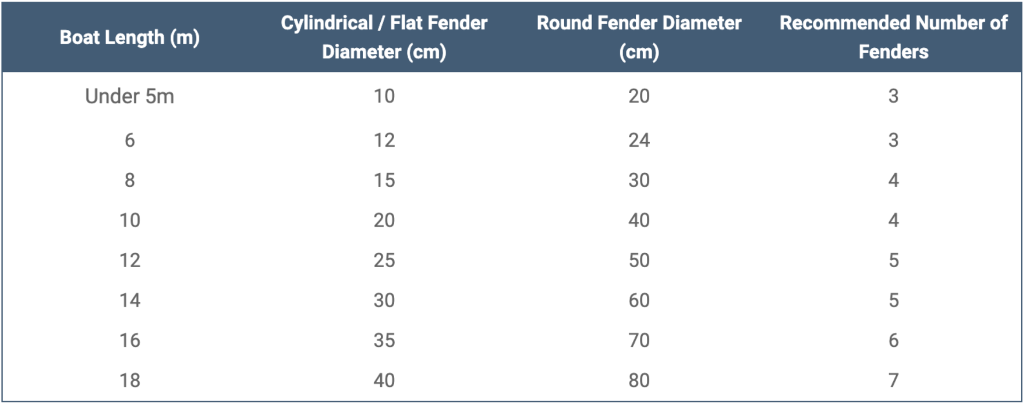Bootsfender
Bootsfender, auch bekannt als Bootspuffer, spielen eine entscheidende Rolle beim Schutz Ihres Bootes vor potenziellen Schäden durch Kontakt mit Docks, Pfählen oder anderen Booten. Wir bieten drei Haupttypen von Bootsfendern an: zylindrische Fender, Kugelfender und Flachfender. Sie haben bei zylindrischen und Kugelfendern die Wahl zwischen aufblasbaren und festen Varianten; Flachfender bestehen stets aus einem festen Material. Typische Materialien für die Herstellung von Bootsfendern sind Gummi, elastischer Schaumstoff und Kunststoff. Polyform Bootsfender sind bekannt für ihre Zuverlässigkeit und werden im Hochdruck-Spritzgussverfahren gefertigt, was ihnen außergewöhnliche Festigkeit verleiht. Sie bestehen aus robustem PVC-Material mit einer stark verstärkten Öse und werden mit Luft aufgeblasen. Mehr lesen...
Je größer das Boot, desto mehr Fender werden benötigt, um optimalen Schutz zu gewährleisten. Aufgrund begrenzten Stauraums an Bord besteht häufig ein Kompromiss zwischen Schutzbedarf und verfügbarem Platz. Aufblasbare Bootsfender aus verstärktem, abriebfestem Material bieten hier eine ideale Lösung. Diese leichten und einfach zu handhabenden Fender lassen sich problemlos im Staufach verstauen, wenn sie nicht benötigt werden.
Wie viele Bootsfender brauche ich?
Bei der Wahl der richtigen Anzahl von Bootsfendern sind drei wichtige Faktoren zu berücksichtigen: Bootslänge, Bootsgewicht und Anlegebedingungen. Wir empfehlen mindestens drei Fender für jedes Boot und zusätzlich mindestens einen Fender pro drei Meter Wasserlinienlänge. Ein Boot mit 6 Metern Länge sollte daher mindestens 3 Bootsfender haben, ein 12-Meter-Boot mindestens 4.
Welche Größe sollten meine Bootsfender haben?
Als Faustregel gilt: Ein zylindrischer Bootsfender sollte etwa 3 cm Durchmesser pro 1,5 Meter Bootslänge aufweisen. Ein Kugelfender sollte etwa 6 cm Durchmesser pro 1,5 Meter Bootslänge besitzen. Die folgende Tabelle bietet eine allgemeine Orientierungshilfe basierend auf einem mittelgroßen Einrumpfboot.

Was sind die Vorteile aufblasbarer Bootsfender?
Aufblasbare Bootsfender kombinieren Robustheit mit Komfort. Sie wiegen etwa halb so viel wie herkömmliche Gummifender und bieten dennoch stabilen Schutz ohne unnötiges Volumen. Ihre kompakte Lagergröße und einfache, schnelle Aufblasbarkeit bieten praktischen Nutzen und sind besonders bei Offshore-Seglern beliebt, die an Bord Platz sparen möchten. Damit bieten aufblasbare Bootsfender zuverlässigen Schutz bei geringem Gewicht und wenig Stauraumbedarf.
Was sind die Vorteile von Flachfendern?
Flachfender verhindern aufgrund ihrer eckigen Form ein Verrutschen oder Rollen und können, ähnlich wie zylindrische Fender, horizontal oder vertikal an der Bordwand angebracht werden. Flachfender sind besonders bei Regattaseglern beliebt, da sie äußerst leicht sind – oft nur ein Drittel des Gewichts eines zylindrischen Fenders haben.
Diese Leichtigkeit ist besonders im Regattasport vorteilhaft, wo jedes Kilogramm zählt. Ihre Stabilität und der feste Sitz am Rumpf sorgen für ausgezeichneten Schutz. Zudem können Flachfender vielseitig verwendet werden, beispielsweise als Sitzkissen oder Matratze, was sie zu einer praktischen Lösung für Regattasegler macht.
Kugel- oder zylindrische Bootsfender – Welche soll ich wählen?
Jede Art von Bootsfender hat spezifische Einsatzbereiche. Zylindrische Fender, die am häufigsten verwendete Form, können vertikal oder horizontal am Rumpf befestigt werden und bieten effektiven Schutz beim Anlegen. Kugelfender, auch Ballfender oder Rundfender genannt, bieten exzellenten Schutz an punktuellen Belastungsstellen und sind ideal für enge Manöver.
Die richtige Fendergröße ist entscheidend, wobei unsere Faustregel empfiehlt, zylindrische Fender mit etwa 3 cm Durchmesser pro 1,5 Meter Bootslänge und Kugelfender mit etwa 6 cm Durchmesser für die gleiche Länge einzusetzen.
Die Entscheidung zwischen Kugel- und Zylinderfendern hängt von den spezifischen Anforderungen Ihres Bootes ab. Kugelfender eignen sich hervorragend für Bug oder Heck, insbesondere wenn der Abstand zum Steg größer ist. Zylindrische Fender hingegen sind aufgrund ihrer einfacheren Lagerung die erste Wahl für die meisten Boote. Üblicherweise kommen 3 bis 5 zylindrische Fender für den primären Kontakt mit dem Dock zum Einsatz, wobei die genaue Anzahl von der Bootsgröße abhängt. Größere Boote verwenden zudem häufig zwei Kugelfender, die bei Manövern frei schwimmen oder strategisch an Bug und Heck positioniert werden, um zusätzlichen Schutz zu bieten.

To install this Web App in your iPhone/iPad press
![]() and then Add to Home Screen.
and then Add to Home Screen.
